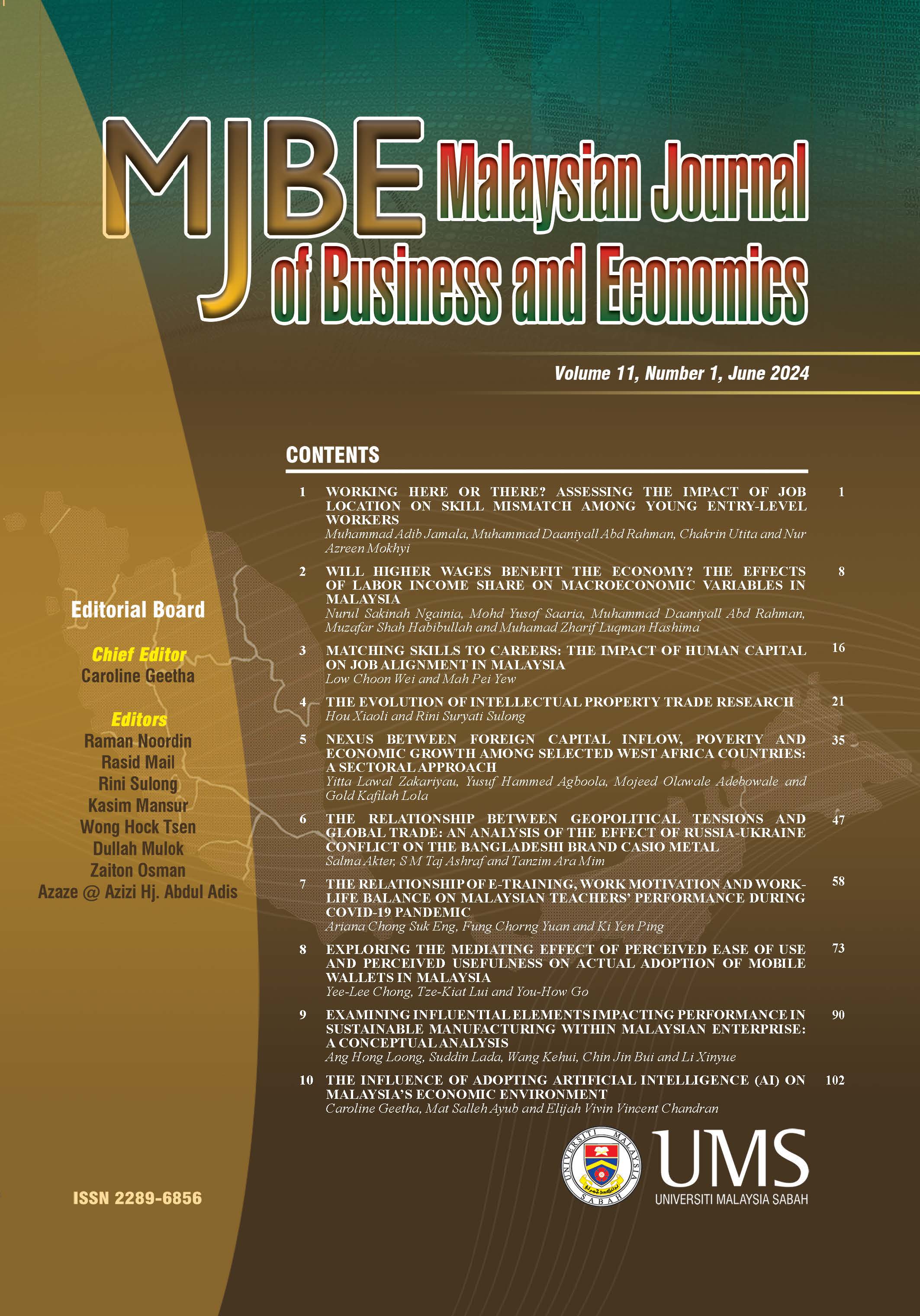THE EVOLUTION OF INTELLECTUAL PROPERTY TRADE RESEARCH
DOI:
https://doi.org/10.51200/mjbe.v11i1.5291Keywords:
Evolution Trend, Intellectual Property Trade, Influencing Factors, Intellectual Property Protection, InnovationAbstract
As an important growth point of the world economy, intellectual property trade is closely related to the division of labor and benefit distribution in the global value chain, and has become an important tool for countries to seek international competitive advantages. However, no systematic literature review has been made on intellectual property trade research. Taking the related research on patents as the object of trade as the research object, this study makes a literature review of the current situation and evolution of intellectual property trade, and its influencing factors. It can be concluded that since the 1980s, the global intellectual property market has expanded with increased transaction scale and international patent technology transactions. Developed countries dominate the market, while China and other emerging countries have risen. The influencing factors include intellectual property protection, economic scale, and geopolitics, amongst others. International protection is essential, and the degree of protection is related to the level of national development. The study found that the current literature on intellectual property trade is far from extensive and in-depth, and there needs to be a scientific framework and system for the research on the theoretical basis and influencing factors.
References
Analysis Group on International Balance of Payment of SAFE (2021) “International Cooperation in Intellectual Property Rights Promotes Mutual Benefit and Win-win Situation.” China Finance (18): 47-48. CNKI.
Ashby, H.B. Monk (2009) “The emerging market for intellectual property: drivers, restrainers, and implications.” Journal of Economic Geography 9 (4) : 469 491. https://doi.org/10.1093/jeg/lbp003.
Ashish, Arora and Alfonso Gambardella (2010) “Ideas for Rent: an Overview of Markets for Technology.” Industrial and Corporate Change 19(3):775 803. https://doi.org/10.1093/icc/dtq022.
Baldwin, R. E. (1997) “The Causes of Regionalism.” The World Economy 20(7):865-888. https://doi.org/10.1111/1467-9701.00107.
Bhagwati J. (1992) “Regionalism Versus Multilateralism.” The World Economy 15(5): 535 555. https://doi.org/10.1111/j.1467-9701.1992.tb00536.x.
Blind, K. and Jungmittag, A. (2005) “Trade and the Impact of Innovations and Standards: The Case of Germany and the UK.” Applied economics 37(12):1385-1398. https://doi.org/10.1080/13504850500143294.
Bosworth, D. and Yang, D. (2000) “Intellectual Property Law, Technology Flow and Licensing Opportunities in the People’s Republic of China.” International Business Review 9(4): 453-477. https://doi.org/10.1016/S0969-5931(00)00013-5.
Branstetter, L. G., Fisman, R. and Foley, C. F. (2006) “Do Stronger Intellectual Property Rights Increase International Technology Transfer? Empirical Evidence from U.S. Firm-Level Panel Data.” Quarterly Journal of Economics 121(1): 321-349. doi:10.1093/qje/121.1.321.
Branstetter, L.G., Fisman, R. and Foley, C. F. and Kamal Saggi (2011) “Does Intellectual Property Rights Reform Spur Industrial Development?” Journal of Development Economics 83(1): 27-36. https://doi.org/10.1016/j.jinteco.2010.09.001.
Chen, Changbai. 1994. International Trade in Intellectual Property. Southeast Nanjing: University Press.
Chin, J. C. and Grossman, G. M. (1988) “Intellectual Property Rights and North-South Trade.” https://www.nber.org/papers/w2769.
Cui, Yanxin (2019) “Study on Development Strategies of Service Trade in Intellectual Property between China and the United States.” Intertrade (04):68-77. doi:10.14114/j.cnki.itrade.2019.04.010.
Dai, Zhongqiang, Liang Junwei and Sun Qi (2015) “Intellectual Property Protection, Economic Development and Technological Sophistication of Service Trade.” Finance & Trade Economics (7):109-122. doi:10.19795/j.cnki.cn11-1166/f.2015.07.009.
Duan, Dezhong, Chen Ying, Du Debin (2019) “Technology Trade Pattern and Change in the Belt and Road Region.” Progress in Geography (07): 998-1008. doi:10.18306/dlkxjz.2019.07.005.
Duan Dezhong, Du Debin, Chen Ying (2019) “Global Geopolitical Pattern on Science & Technology from the Perspective of Intellectual Property Trade.” Geographic Research (09): 2115-2128. doi:CNKI :SUN:DLYJ.0.2019-09-002.
Egea, Alejandro Nadal (1975) Multinational Corporations in the Operation and Ideology of International Transfer of Technology. Studies in Comparative International Development (10): 11-29. https://doi.org/10.1007/BF02800424.
Feng, Zhigang, Zhang Zhiqiang and Liu Hao (2022) “The Evolution Law of International Technology Trade Pattern: The Perspective of Data Analysis of Charges for the Use of Intellectual Property.” Journal of the China Society for Scientific and Technical Information (01): 38-49. doi: CNKI: SUN: QBXB.0.2022-01-005.
Gu, Xiaoyan and Liu Li (2014) “The Impact of Intellectual Property Trade on Technological Innovation in China’s High techIndustries.” Inquiry into Economic Issues(12): 50-54. doi:CNKI:SUN:JJWS.0.2014-12-010.
Gu, Xiaoyan and Shi Xinhe (2014) “An Empirical Study of Factors Influencing China’s Export of Intellectual Property Trade.” On Economic Problems(11):98-101. doi:10.16011/j.cnki.jjwt.2014.11.044.
Hall, G. R. and Johnson, R. E. (1970) “Transfers of United States aerospace technology to Japan.” In The Technology Factor in International Trade, edited by Raymond Vernon, 305-363. Cambridge:NBER. http://www.nber.org/chapters/c3383.
He, Qiongjun (1996) The Resource Allocation Mechanism of Intellectual Property Trade. South China Journal of Economics (4):53-54.CNKI.
Ivus, Olena (2010) “Do Stronger Patent Rights Raise High-Tech Exports to the Developing World?” Journal of International Economics 81(1): 38-47. https://doi.org/10.1016/j.jinteco.2009.12.002.
Ivus, O., Park, W. and Saggi, K. (2016) “Intellectual Property Protection and the Industrial Composition of Multinational Activity.” Journal of International Economics 54(2): 1068-1085. doi:10.1111/ecin.12314.
Li, Hao (2005) On Our country’s Intellectual Property Rights Trade: Problems and Countermeasures. Journal of International Trade (11): 118-122.CNKI.
Liu, Diling (2016) “Research on the Development Countermeasures of China's Technology Trade under the New Situation.” Intertrade (09):28-31. doi:10.14114/j.cnki.itrade.2016.09.008.
Liu, Qiang and Li Benqian (2016) “A Comparative Research on International Competitiveness Evolution of Intellectual Property Service Trade in 8 Countries.” Science and Technology Management Research 36(12): 135-139. doi:10. 3969 /j. issn. 1000-7695.2016. 12. 025.
Lun, Rui (2007) “Comparative Study on the Impact of Different Foreign-related Economic Activities on Industrial Technology Innovation Ability.” Science of Science and Management of S.& T.(01):66-72. CNKI.
Downloads
Published
Versions
- 30-06-2024 (4)
- 30-06-2024 (3)
- 30-06-2024 (2)
How to Cite
Issue
Section
License

CCBY (Attribution)
https://creativecommons.org/licenses/by/4.0/
© Universiti Malaysia Sabah 2025
All rights reserved. No part of this publication may be reproduced, distributed, stored in a database or retrieval system, or transmitted, in any form or by any means, electronic, mechanical, graphic, recording or otherwise, without the prior written permission of Universiti Malaysia Sabah Press, except as permitted by Act 332, Malaysian Copyright Act of 1987. Permission of rights is subjected to the journal.









